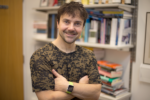 In an interview with Suzan Mazur at Huffington Post. Mazur explains,
In an interview with Suzan Mazur at Huffington Post. Mazur explains,
Plug certain information into SUPERFAMILY and it can analyze a vast assortment of genomes and assist you in building a Tree of Life using superfamilies — i.e., domains with an evolutionary relationship — and the conserved part of thousands and thousands of protein structures called protein domains.
…
Suzan Mazur: Do protein Superfamilies represent the current limits of our ability to identify common ancestry?
Julian Gough: Yes. That is exactly what their definition is. So if you want to group two protein structural domains into the same Superfamily, the question that you ask is whether there is structural sequence and functional evidence for common evolutionary ancestry. So they’re classified based on that.
The most powerful part of that classification comes from the structure. Structure is far more conserved than sequence and so the knowledge of the structure allows you to classify very distantly related things that have no apparent or detectable similarity in sequence.More.
Suzan Mazur is the author of Public Evolution Summit.
See also: Axe on specific barriers to macro-level Darwinian Evolution due to protein formation (and linked islands of specific function)
Follow UD News at Twitter!